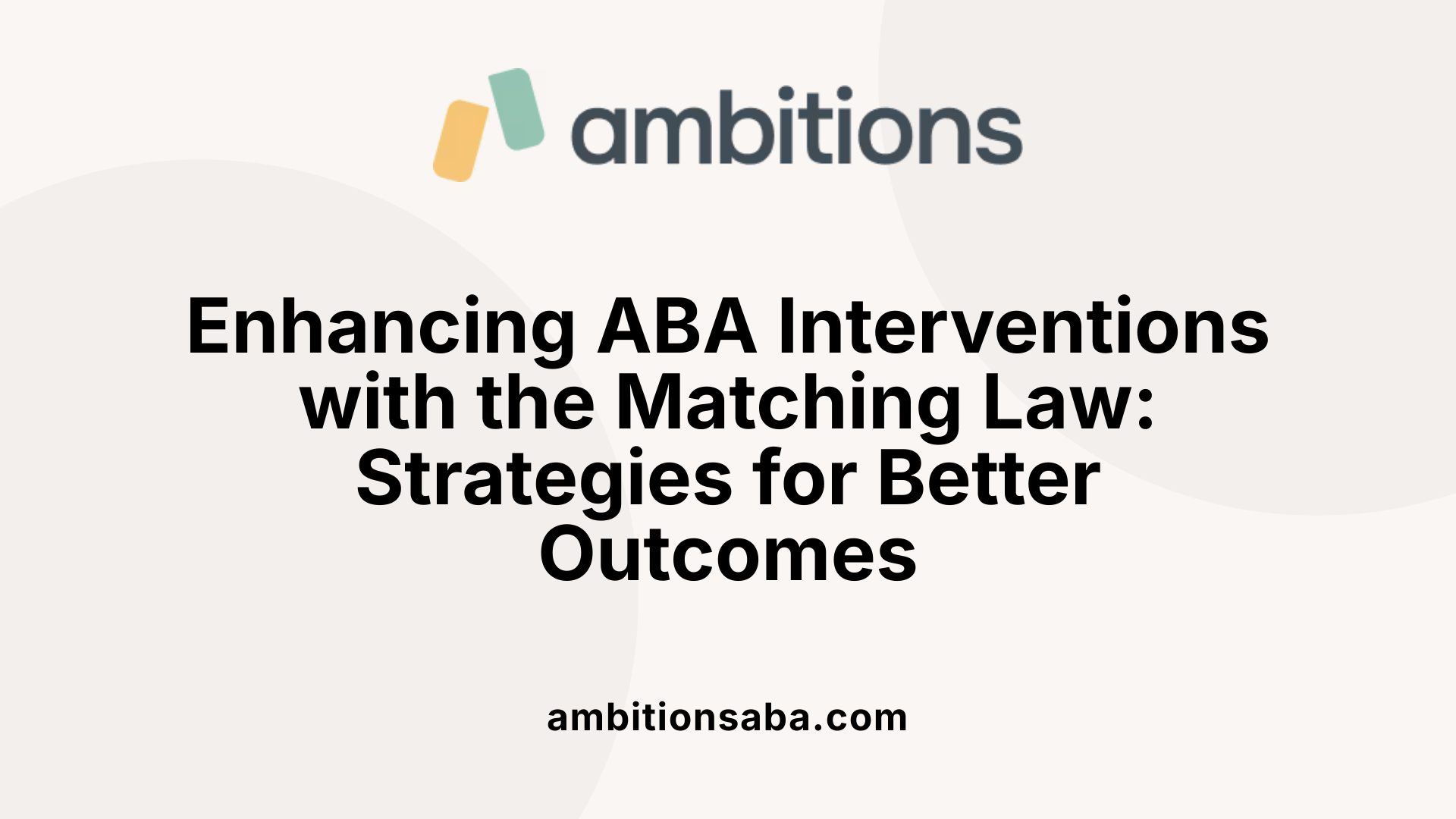Exploring Behavioral Principles in ABA
Applied Behavior Analysis (ABA) therapy is a cornerstone in the treatment of autism, utilizing behavioral science principles to improve essential skills and reduce problematic behaviors. Central to optimizing ABA interventions is the concept of the matching law—a principle that predicts how individuals allocate their responses based on reinforcement rates. This article delves into what the matching law is, how it applies within the context of ABA therapy, and how understanding it can enhance therapeutic outcomes for individuals with autism.
What Is Matching Law and Why Does It Matter in ABA?

What is matching law?
The matching law predicts that the proportion of responses an individual allocates to different behaviors corresponds directly to the proportion of reinforcement received from those behaviors. In other words, behaviors are chosen based on their relative rates of reinforcement.
How do reinforcement rates influence response allocation?
According to the matching law, when a behavior is reinforced more frequently or consistently, an individual is more likely to allocate more of their responses to that behavior. This means that the likelihood of performing a particular behavior is directly related to how often it leads to a reward or positive outcome.
Why is matching law relevant to behavior selection in ABA?
In Applied Behavior Analysis (ABA), understanding matching law helps practitioners predict and influence which behaviors clients will choose. By adjusting reinforcement rates for different behaviors, therapists can guide clients to prefer more desirable or adaptive behaviors. This foundational principle supports the design of interventions that shape behavior effectively by manipulating reinforcement schedules.
Applied Behavior Analysis (ABA) Therapy: Foundations and Providers

What is the matching law and how does it relate to behavior choices in ABA?
The matching law is a behavioral principle that predicts how individuals allocate their responses among available options based on the rate of reinforcement they receive from each behavior. In the context of ABA therapy, it helps explain why a person might choose certain behaviors over others depending on which are reinforced more frequently or more effectively. This understanding is crucial for therapists aiming to guide clients toward more adaptive behaviors.
How do practitioners use the matching law to encourage positive behaviors?
ABA practitioners can strategically adjust reinforcement schedules to influence which behaviors a client is more likely to engage in. For example, by increasing reinforcement for on-task behaviors—such as following instructions or completing assignments—therapists encourage the client to allocate more responses to these desirable behaviors. This method enhances motivation and effectiveness without relying on punishment.
How is the matching law applied in addressing problem behaviors?
When problematic behaviors occur, the matching law guides intervention by reinforcing alternative, more appropriate behaviors. For instance, if a child seeks attention through disruptive actions, therapists can reinforce requesting help or other socially acceptable communication instead. By increasing reinforcement for these alternative behaviors, the child’s response allocation shifts away from problem behaviors toward more constructive ones.
How does the matching law assist in evaluating the effectiveness of ABA treatments?
The matching law provides quantitative data for assessing treatment outcomes. By comparing how a client's responses are allocated before and after an intervention—such as measuring changes in the frequency of targeted behaviors—therapists can evaluate the impact of reinforcement strategies. This objective measurement supports data-driven decision-making in refining treatment plans.
Can the matching law be applied in group settings?
Yes, in group therapy or classroom environments, the matching law helps predict how individuals allocate their behavior based on the different reinforcement patterns they receive from peers, teachers, or therapists. Understanding these dynamics allows practitioners to design reinforcement schedules that promote positive interactions and reduce undesirable behaviors within the group.
| Aspect | Application in ABA Therapy | Impact on Intervention |
|---|---|---|
| Behavior Selection | Predicts how clients choose behaviors based on reinforcement rates | Guides reinforcement schedules to increase desired behaviors |
| Problem Behavior | Reinforces alternative appropriate behaviors | Shifts behavior away from problematic actions |
| Treatment Evaluation | Compares response allocation before and after intervention | Provides objective data for treatment effectiveness |
| Group Settings | Assesses responses based on differential reinforcement in social contexts | Enhances positive engagement and behavior management |
Applying Matching Law to Enhance Behavioral Interventions in ABA

How is matching law used in ABA therapy?
Practitioners utilize the matching law to guide how behaviors are selected and reinforced during therapy. This principle explains that individuals allocate their responses in proportion to the reinforcement received for each behavior. In practical terms, therapists adjust reinforcement schedules to favor desirable behaviors.
Using matching law to adjust reinforcement schedules
By increasing the reinforcement frequency or magnitude for positive, on-task behaviors, therapists can encourage clients to engage more in those behaviors. This strategic adjustment helps prioritize constructive actions over less desirable ones.
Shaping desirable behaviors
Reinforcement is not limited to direct behaviors but can include alternative, acceptable responses. For instance, teaching a client to request help instead of engaging in problem behaviors is reinforced. This shifts the response allocation toward positive alternatives, improving overall behavioral outcomes.
Intervention strategies for problem behaviors
When addressing problem behaviors, the matching law supports an intervention approach that focuses on reinforcing alternative behaviors rather than simply punishing negative ones. This method helps clients gradually replace inappropriate behaviors with more functional responses that receive greater reinforcement.
Predicting client choices
In group or social settings, the matching law enables therapists to predict how clients will allocate their behaviors based on the reinforcement patterns they experience. Understanding these dynamics helps tailor interventions more effectively and anticipate behavioral shifts.
Overall, applying matching law principles provides a quantitative framework to evaluate treatment effectiveness, comparing behavior response allocation before and after intervention to track progress and adjust strategies.
Evaluating ABA Therapy Effectiveness Through Matching Law Principles
How is the progress of a person undergoing ABA therapy measured?
Progress in ABA therapy is measured through systematic data collection focused on observable behaviors. Practitioners use tools such as frequency counts, duration recordings, and skill acquisition tracking to gather detailed information about the individual's behavior patterns. This data is instrumental in assessing improvement and adjusting interventions as needed.
Measuring response allocation
The matching law offers a framework to predict how individuals allocate their responses based on the reinforcement rates they receive. By observing shifts in response allocation before and after an intervention, therapists can quantitatively assess how effective their treatment strategies are at promoting desirable behaviors.
Data collection and analysis in ABA
Data collection in ABA involves recording specific responses and the reinforcement schedules applied. These data points are analyzed to identify changes in behavior frequency and preference, helping practitioners understand how reinforcement influences choices.
Quantitative evaluation of treatment outcomes
Using the matching law, treatment outcomes are evaluated by comparing response allocation patterns pre- and post-intervention. This quantitative approach provides objective evidence of progress and helps tailor reinforcement strategies to encourage positive behaviors.
| Aspect | Description | Role in Evaluation |
|---|---|---|
| Response Allocation | Distribution of behaviors based on reinforcement | Indicates behavior preference and therapy impact |
| Reinforcement Schedules | Patterns of delivering reinforcement | Used to modify behavior and promote desired responses |
| Data Collection Methods | Frequency counts, duration, skill tracking | Provides measurable indicators of progress |
| Quantitative Analysis | Comparing pre- and post-intervention data | Objective measure of treatment effectiveness |
Group Settings and Broader Implications of Matching Law in ABA

How does the matching law help in predicting group behavior based on reinforcement?
In group settings, the matching law anticipates how individuals will allocate their responses according to the varying rates of reinforcement they receive from different social interactions. This means that people are more likely to engage in behaviors that are reinforced more frequently or more strongly within the group. By understanding this, practitioners can predict which social actions individuals will favor, based on the reinforcement patterns in place.
What are the behavioral dynamics in social contexts influenced by the matching law?
Social environments often present multiple sources of reinforcement simultaneously. The matching law explains how individuals distribute their behaviors among these competing options, balancing their actions to maximize reinforcement. This dynamic can clarify why certain behaviors dominate in group settings and how shifts in reinforcement can alter social interactions.
How can the matching law enhance social skills through reinforcement?
By strategically increasing reinforcement for positive social behaviors, such as sharing, cooperation, or requesting help, practitioners can encourage these behaviors to become more frequent. For example, providing consistent praise or rewards for on-task and prosocial behaviors can lead to greater engagement and improved social competence in group activities. This targeted use of reinforcement fosters better social skills and supports collaborative success within groups.
Integrating Matching Law for Optimized ABA Outcomes
The matching law serves as a valuable framework for understanding and guiding behavior choices within ABA therapy for autism. By leveraging principles of reinforcement proportionality, practitioners can more effectively promote desired behaviors, tailor interventions, and quantitatively measure progress. This insight not only advances individualized treatment plans but also informs strategies in group environments where social interactions influence behavior patterns. Ultimately, incorporating the matching law enriches ABA's evidence-based approach, helping individuals with autism achieve meaningful improvements in their daily lives.
References
- Identify Ways the Matching Law can be Used to Interpret ...
- Applied Behavior Analysis (ABA)
- Applied Behavioral Analysis (ABA) Therapists in Michigan
- Who can provide ABA therapy?
- The Controversy Around ABA
- Is ABA therapy harmful? The controversy explained
- ABA Techniques: Strategies for Behavior Analysts - GSEP Blog



